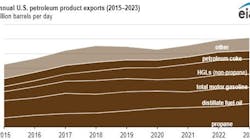Energy prices continued climbing Dec. 21 along with the stock markets, which continued rallying in early trading Dec. 22 after the Labor Department announced initial applications for US unemployment benefits declined for the third consecutive week, down 4,000 to 364,000 for the week ended Dec. 16.
On the other hand, the government reduced its estimate of US economic growth during the third quarter to an annual rate of 1.8% from the 2% previously reported. That’s still the best growth rate of this year, however. Economists are hoping an improving job market—or at least a reduction in layoffs, with an 8.6 unemployment rate in November down from 9% for the previous 2 years—along with a seasonal decline in gasoline prices and a general lack of cold weather to drive up natural gas and fuel oil prices will leave consumers more money for strong holiday shopping to boost economic growth above 3% for the final quarter of this year.
Oil prices have managed to hold up in the face of a strengthening dollar “most likely due to optimism surrounding the health of the US economy,” said analysts at Standard New York Securities Inc., the Standard Bank Group. Additional US economic data scheduled for release today might further influence energy markets, “especially in light of the pre-holiday lack of liquidity,” they said. Market activity appeared to be winding down ahead of the 4-day Christmas holiday weekend.
US inventories
The Energy Information Administration reported Dec. 22 the withdrawal of 100 bcf of natural gas from US underground storage in the week ended Dec. 16. That left 3.63 tcf of working gas in storage, 235 bcf more than at the same time last year and 387 bcf above the 5-year average.
EIA earlier said commercial US crude inventories fell 10.6 million bbl to 323.6 million bbl that same week, far surpassing Wall Street’s consensus for a 2.1 million bbl decline. Gasoline stocks decreased 400,000 bbl to 218.4 million barrels, opposite expectations of a 1.5 million bbl gain. Distillate fuel inventories dropped 2.4 million bbl to 139.1 million bbl, beyond the market outlook for an 800,000 bbl decline (OGJ Online, Dec. 21, 2011).
“The weekly draw in stocks basically wipes out the stock build of the last 2 weeks,” said Olivier Jakob at Petromatrix in Zug, Switzerland.
The EIA report of oil inventories showed “a substantial stock draw of 18 million bbl,” including 14 million bbl in the main crude plus clean petroleum products category, with 11 million bbl coming from crude, Jakob noted. “We must take those 11 million bbl of crude oil stock draw with some caution,” he warned. “First, 5 million bbl were in [the DOE’s Petroleum Administration for Defense District] PADD 5 [on the West Coast], which is discounted [because it] is disconnected from the rest of the US” by the Rockies as far as movement of crude and petroleum products.
Second, he said, “The Houston Ship Channel was shut during most of the week, resulting in many ships waiting outside the channel and not being able to discharge their cargo. The reported crude oil imports into the US Gulf Coast at 3.7 million b/d are a clear statistical outlier, and therefore we need to take the 7 million bbl crude oil stock draw in the US Gulf Coast with a big pinch of salt. Over the last 10 years, there has been only 1 week where gulf coast crude oil imports were reported lower; in other words, if the weekly gulf coast crude oil imports were representative, we would be heading into a total shutdown of gulf coast refineries, and we do not think that this is yet the case. We also need to consider the seasonality of crude oil stock draws in December, replaced by stock build in January and February.”
EIA showed a 1 million bbl draw from crude stocks in Cushing, Okla., but a 1 million bbl stock build in the Midwestern PADD 2, which includes Cushing. “The 4-week average of crude oil imports into PADD 2 has reached a new all-time record high,” Jakob said.
The small decline in US gasoline stocks last week “is insignificant given the overall levels of US stocks and poor consumer demand,” said Jakob. “On the other hand, the distillate stocks had a 2.3 million bbl stock draw, which continues to make distillate stocks trending towards 2007-2008 levels.”
He said, “Technically, West Texas Intermediate is still aiming for the resistance of $100/bbl as we are getting closer to the long Christmas weekend. Front-rolling WTI is now down 2.28% for the year and still needs an additional push higher to end the year in the green; the Standard & Poor’s 500 Index, however, was stalling a bit yesterday.” Jakob said, “On WTI we draw a first resistance at $99.30/bbl and then $100/bbl. First support [is] at $98.70/bbl, then $97.50/bbl. The 200-day moving average is at $95.80/bbl.”
Energy prices
The new front-month February contract and the March contract for benchmark US sweet, light crudes were up $1.43 each to $98.67/bbl and $98.85/bbl, respectively, Dec. 21 on the New York Mercantile Exchange. On the US spot market, WTI at Cushing increased $1.45 to $98.67/bbl.
Heating oil for January delivery gained 5.93¢ to $2.91/gal on NYMEX. Reformulated stock for oxygenate blending for the same month rose 4.12¢ to $2.62/gal.
The February natural gas contract advanced 2.7¢ to $3.16/MMbtu on NYMEX. On the spot market, gas at Henry Hub, La., inched up 0.1¢ to a rounded $3.04/MMbtu on Dec. 21 from a rounded $3.03/MMbtu on Dec. 19, the last previous date for which a price was available.
In London, the February IPE contract for North Sea Brent increased 98¢ to $107.71/bbl. Gas oil for January gained $8.25 to $910.50/tonne.
The average price for the Organization of Petroleum Exporting Countries’ basket of 12 benchmark crudes increased $1.93 to $106.98/bbl.
Contact Sam Fletcher at [email protected]

